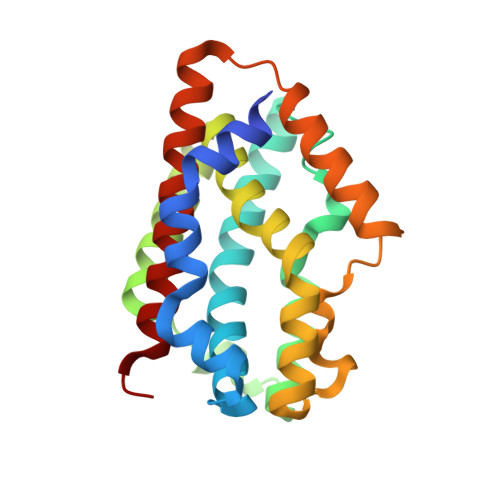Design of metal cofactors activated by a protein-protein electron transfer system.
Ueno, T., Yokoi, N., Unno, M., Matsui, T., Tokita, Y., Yamada, M., Ikeda-Saito, M., Nakajima, H., Watanabe, Y.(2006) Proc Natl Acad Sci U S A 103: 9416-9421
- PubMed: 16769893
- DOI: https://doi.org/10.1073/pnas.0510968103
- Primary Citation of Related Structures:
1WZD, 1WZF, 1WZG - PubMed Abstract:
Protein-to-protein electron transfer (ET) is a critical process in biological chemistry for which fundamental understanding is expected to provide a wealth of applications in biotechnology. Investigations of protein-protein ET systems in reductive activation of artificial cofactors introduced into proteins remains particularly challenging because of the complexity of interactions between the cofactor and the system contributing to ET. In this work, we construct an artificial protein-protein ET system, using heme oxygenase (HO), which is known to catalyze the conversion of heme to biliverdin. HO uses electrons provided from NADPH/cytochrome P450 reductase (CPR) through protein-protein complex formation during the enzymatic reaction. We report that a Fe(III)(Schiff-base), in the place of the active-site heme prosthetic group of HO, can be reduced by NADPH/CPR. The crystal structure of the Fe(10-CH(2)CH(2)COOH-Schiff-base).HO composite indicates the presence of a hydrogen bond between the propionic acid carboxyl group and Arg-177 of HO. Furthermore, the ET rate from NADPH/CPR to the composite is 3.5-fold faster than that of Fe(Schiff-base).HO, although the redox potential of Fe(10-CH(2)CH(2)COOH-Schiff-base).HO (-79 mV vs. NHE) is lower than that of Fe(Schiff-base).HO (+15 mV vs. NHE), where NHE is normal hydrogen electrode. This work describes a synthetic metal complex activated by means of a protein-protein ET system, which has not previously been reported. Moreover, the result suggests the importance of the hydrogen bond for the ET reaction of HO. Our Fe(Schiff-base).HO composite model system may provide insights with regard to design of ET biosystems for sensors, catalysts, and electronics devices.
- Research Center for Materials Science, Graduate School of Science, Nagoya University, Furo-cho, Chikusa-ku, Nagoya 464-8602, Japan.
Organizational Affiliation:



















